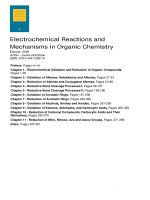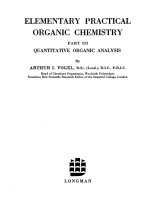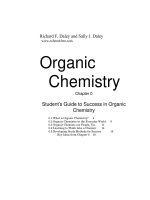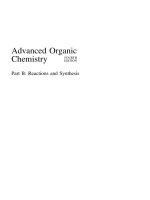Ebook Arrow pushing in organic chemistry Part 1
Bạn đang xem bản rút gọn của tài liệu. Xem và tải ngay bản đầy đủ của tài liệu tại đây (1.47 MB, 119 trang )
Arrow Pushing in
Organic Chemistry
An Easy Approach to Understanding
Reaction Mechanisms
Daniel E. Levy
Arrow Pushing in
Organic Chemistry
Arrow Pushing in
Organic Chemistry
An Easy Approach to Understanding
Reaction Mechanisms
Daniel E. Levy
Copyright # 2008 by John Wiley & Sons, Inc. All rights reserved
Published by John Wiley & Sons, Inc., Hoboken, New Jersey
Published simultaneously in Canada
No part of this publication may be reproduced, stored in a retrieval system, or transmitted in any form or by
any means, electronic, mechanical, photocopying, recording, scanning, or otherwise, except as permitted
under Sections 107 or 108 of the 1976 United States Copyright Act, without either the prior written
permission of the Publisher, or authorization through payment of the appropriate per-copy fee to the
Copyright Clearance Center, Inc., 222 Rosewood Drive, Danvers, MA 01923, (978) 750-8400, fax (978)
750-4470, or on the web at www.copyright.com. Requests to the Publisher for permission should be
addressed to the Permissions Department, John Wiley & Sons, Inc., 111 River Street, Hoboken, NJ 07030,
(201) 748-6011, fax (201) 748-6008, or online at />Limit of Liability/Disclaimer of Warranty: While the publisher and author have used their best efforts
in preparing this book, they make no representations or warranties with respect to the accuracy or
completeness of the contents of this book and specifically disclaim any implied warranties of
merchantability or fitness for a particular purpose. No warranty may be created or extended by sales
representatives or written sales materials. The advice and strategies contained herein may not be suitable
for your situation. You should consult with a professional where appropriate. Neither the publisher nor
author shall be liable for any loss of profit or any other commercial damages, including but not limited to
special, incidental, consequential, or other damages.
For general information on our other products and services or for technical support, please contact our
Customer Care Department within the United States at (800) 762-2974, outside the United States at (317)
572-3993 or fax (317) 572-4002.
Wiley also publishes its books in variety of electronic formats. Some content that appears in print may not be
available in electronic format. For more information about Wiley products, visit our web site at
www.wiley.com.
Library of Congress Cataloging-in-Publication Data is available.
ISBN 978-0-470-17110-3
Printed in the United States of America
10 9 8
7 6
5 4 3
2 1
Dedicated to the memory of Henry Rapoport (1918 – 2002)
Professor of Chemistry, Emeritus
University of California — Berkeley
A true teacher and mentor
Contents
PREFACE
xi
ACKNOWLEDGMENTS
xiii
ABOUT THE AUTHOR
xv
1. Introduction
1.1 Definition of Arrow Pushing
1.2 Functional Groups
1.3 Nucleophiles and Leaving Groups
1.4 Summary
Problems
2. Acids
2.1 What are Acids?
2.2 What is Resonance?
2.3 How is Acidity Measured?
2.4 Relative Acidities
2.5 Inductive Effects
2.6 Inductive Effects and Relative Acidities
2.7 Relative Acidities of Hydrocarbons
2.8 Summary
Problems
1
1
5
8
8
10
19
19
20
23
25
29
31
33
34
35
vii
viii
CONTENTS
3. Bases and Nucleophiles
3.1 What are Bases?
3.2 What are Nucleophiles?
3.3 Leaving Groups
3.4 Summary
Problems
45
45
50
54
55
56
4. SN2 Substitution Reactions
4.1 What is an SN2 Reaction?
4.2 What are Leaving Groups?
4.3 Where Can SN2 Reactions Occur?
4.4 SN20 Reactions
4.5 Summary
Problems
65
65
67
68
71
73
74
5. SN1 Substitution Reactions
83
What is an SN1 Reaction?
How are SN1 Reactions Initiated
The Carbocation
5.3.1 Molecular Structure and Orbitals
5.3.2 Stability of Carbocations
5.4 Carbocation Rearrangements
5.4.1 1,2-Hydride Shifts
5.4.2 1,2-Alkyl Shifts
5.4.3 Preventing Side Reactions
5.5 Summary
Problems
5.1
5.2
5.3
6. Elimination Reactions
6.1 E1 Eliminations
6.2 E2 Eliminations
6.3 How Do Elimination Reactions Work?
6.4 Summary
Problems
7. Addition Reactions
7.1
7.2
7.3
Addition of Halogens to Double Bonds
Markovnikov’s Rule
Additions to Carbonyls
7.3.1 1,2-Additions
7.3.2 1,4-Additions
7.3.3 Addition – Elimination Reactions
7.4 Summary
Problems
83
84
86
86
90
92
92
93
95
96
97
101
101
104
105
108
109
115
115
117
119
119
121
123
125
126
CONTENTS
8. Moving Forward
8.1 Functional Group Manipulations
8.2 Name Reactions
8.3 Reagents
8.4 Final Comments
Problems
ix
135
135
139
143
144
146
Appendix 1. pKa Values of Protons Associated with Common
Functional Groups
155
Appendix 2. Answers and Explanations to Problems
159
Chapter
Chapter
Chapter
Chapter
Chapter
Chapter
Chapter
Chapter
1
2
3
4
5
6
7
8
Solutions
Solutions
Solutions
Solutions
Solutions
Solutions
Solutions
Solutions
159
173
191
205
223
233
243
261
Appendix 3. Student Reaction Glossary
283
Index
287
Periodic Table of the Elements
301
Preface
Organic chemistry is a general requirement for most students pursuing degrees in the fields
of biology, physiology, medicine, chemical engineering, biochemistry, and chemistry.
Consequently, many of the students studying organic chemistry initially do so out of
obligations to required curriculum rather than out of genuine interest in the subject. This
is, in fact, expected as almost all college students find themselves enrolling in classes in
which they either have no interest or cannot foresee application of the subject to their
future vocation. Alternatively, there are students who are intrigued with the potential
application of organic chemistry to fields including pharmaceuticals, polymers, pesticides,
food science, and energy. However, whichever group represents the individual students,
there is always a common subset of each that tenuously approaches the study of organic
chemistry due to rumors or preconceived notions that the subject is extremely difficult
and requires extensive memorization. Having personally studied organic chemistry, and
tutored many students in the subject, I assure you that this is not the case.
When first presented with organic chemistry course material, one can easily be caught up
in the size of the book, the encyclopedic presentation of reactions, and the self-questioning
of how one can ever decipher the subject. These students frequently compile endless sets of
flash cards listing specific chemical reactions and their associated names. Like many of my
classmates, I began to approach the subject in this manner. However, this strategy did
not work for me as I quickly realized that memorization of reactions did not provide any
deductive or predictive insight into the progression of starting materials to products and
by what mechanisms the transformations occurred. In fact, the fundamental fault in the
“memorization strategy” is that in order to be effective, the student must not only memorize
all chemical reactions and associated reaction names, but also all associated reaction mechanisms and potential competing processes. It was not until I abandoned the memorization
strategy that I began to do well in organic chemistry and develop a true appreciation for the
subject and how the science benefits society.
The presumption that introductory organic chemistry entails very little memorization is
valid and simplifies the subject provided the student adheres to the philosophy that the study
xi
xii
PREFACE
of organic chemistry can be reduced to the study of interactions between organic acids and
bases. From this perspective, organic chemistry students can learn to determine the most
acidic proton in a given molecule, determine the most reactive site (for nucleophilic
attack), determine the best reactants (nucleophiles and electrophiles), and how to predict
reaction products. In learning to predict these components of organic reactions, the beginning organic chemist will be able to deduce reasonable routes from starting materials to
products using the basic mechanistic types involved in introductory organic chemistry.
Furthermore, through an understanding of how electrons move, extrapolations from ionic
or heterolytic mechanisms can be used to explain free radical and electrocyclic processes.
Finally, by utilizing the principles discussed in this book, the student will gain a better
understanding of how to approach the more advanced reaction types discussed as the
introductory organic chemistry course progresses.
The goal of this book is not to present a comprehensive treatment of organic chemistry.
Furthermore, this book is not intended to be a replacement for organic chemistry texts or
to serve as a stand-alone presentation of the subject. This book is intended to supplement
organic chemistry textbooks by presenting a simplified strategy to the study of the subject in
the absence of extensive lists of organic reactions. Through application of the principles
presented herein, it is my hope that this book, when used as intended, will aid the beginning
student in approaching organic chemistry as I did—with little memorization and much
understanding.
DANIEL E. LEVY, PH.D.
Acknowledgments
I would like to express my deepest appreciation to my wife, Jennifer, and to my children,
Aaron, Joshua, and Dahlia, for their patience and support while writing this book. I would
also like to express a special thanks to Dr. Lane Clizbe for his editorial contributions.
xiii
About the Author
Daniel E. Levy received his Bachelor of Science in 1987 from the University of California
at Berkeley where, under the direction of Professor Henry Rapoport, he studied the
preparation of 4-amino-4-deoxy sugars and novel analogs of pilocarpine. Following
his undergraduate studies, Dr. Levy pursued his Ph.D. at the Massachusetts Institute of
Technology. Under the direction of Professor Satoru Masamune, he studied sugar modifications of amphotericin B, the total synthesis of calyculin A and the use of chiral isoxazolidines as chiral auxiliaries. In 1992, Dr. Levy completed his Ph.D. and has since worked on
various projects involving the design and synthesis of novel organic compounds. These
compounds include glycomimetic inhibitors of fucosyl transferases and cell adhesion
molecules, peptidomimetic matrix metalloproteinase inhibitors, carbocyclic AMP analogs
as inhibitors of type V adenylyl cyclase, heterocyclic ADP receptor antagonists, and
inhibitors of calmodulin-dependent kinase. Dr. Levy is currently the director of synthetic
chemistry at Intradigm Corporation in Palo Alto, California.
Arrow Pushing in Organic Chemistry is Dr. Levy’s third book. In 1995, Dr. Levy
co-authored a book entitled The Chemistry of C-Glycosides (1995, Elsevier Sciences).
Collaborating with Dr. Pe´ter Fu¨gedi, Dr. Levy developed and presented short courses
entitled “Modern Synthetic Carbohydrate Chemistry” and “The Organic Chemistry of
Sugars,” which were offered by the American Chemical Society Continuing Education
Department. With Dr. Fu¨gedi, Dr. Levy co-edited his second book entitled The Organic
Chemistry of Sugars (2005, CRC Press).
xv
Chapter
1
Introduction
The study of organic chemistry focuses on the chemistry of materials essential for life.
Specifically, organic chemistry defines the science surrounding the chemistry of elements
essential for life to exist. In addition to carbon, the most common elements present
in organic molecules are hydrogen, oxygen, nitrogen, sulfur, and various halogens.
Through the study of organic chemistry, our understanding of the forces binding these
elements to one another and how these bonds can be manipulated are explored. In
general, our ability to manipulate organic molecules is influenced by several factors that
include the nature of functional groups near sites of reaction, the nature of reagents utilized
in reactions, and the nature of potential leaving groups. Additionally, these three factors
impart further variables that influence the course of organic reactions. For example, the
nature of the reagents used in given reactions can influence the reaction mechanisms
and ultimately the reaction products. By recognizing the interplay between these factors
and by applying principles of arrow pushing, which really represents bookkeeping of electrons, reasonable predictions of organic mechanisms and products can be realized without
the burden of committing to memory the wealth of organic reactions studied in introductory courses. In this chapter, the concept of arrow pushing is defined in context with
various reaction types, functional groups, mechanism types, reagents/nucleophiles, and
leaving groups.
1.1
DEFINITION OF ARROW PUSHING
Organic chemistry is generally presented through a treatment of how organic chemicals
are converted from starting materials to products. For example, the Wittig reaction
(Scheme 1.1) is used for the conversion of aldehydes and ketones to olefins, the
Arrow Pushing in Organic Chemistry: An Easy Approach to Understanding Reaction Mechanisms.
By Daniel E. Levy
Copyright # 2008 John Wiley & Sons, Inc.
1
2
INTRODUCTION
Scheme 1.1 Example of the Wittig reaction.
Scheme 1.2 Example of the Diels– Alder reaction.
Scheme 1.3 Example of a tin hydride dehalogenation.
Diels – Alder reaction (Scheme 1.2) is used for the formation of six-membered ring
systems, and treatment of alkyl halides with reagents such as tributyltin hydride
(Scheme 1.3) results in removal of the associated halides. However, by presenting these
reactions as illustrated in Schemes 1.1, 1.2, and 1.3, no explanation is provided as to
how the starting materials end up as their respective products.
By definition, the outcome of any chemical reaction is the result of a process resulting in
the breaking and formation of chemical bonds. Referring to material covered in most
general chemistry courses, bonds between atoms are defined by sets of two electrons.
Specifically, a single bond between two atoms is made of two electrons, a double bond
between atoms is made of two sets of two electrons, and a triple bond between atoms is
made of three sets of two electrons. These types of bonds can generally be represented
by Lewis structures using pairs of dots to illustrate the presence of an electron pair. In
organic chemistry, these dots are most commonly replaced with lines. Figure 1.1 illustrates
several types of chemical bonds in both electron dot notation and line notation. The list of
bond types shown in Figure 1.1 is not intended to be inclusive with respect to functional
groups or potential combinations of atoms.
While chemical bonds are represented by lines connecting atoms, electron dot notation is
commonly used to represent lone pairs (nonbonding pairs) of electrons. Lone pairs are
found on heteroatoms (atoms other than carbon or hydrogen) that do not require bonds
with additional atoms to fill their valence shell of eight electrons. For example, atomic
1.1
DEFINITION OF ARROW PUSHING
3
Figure 1.1 Examples of chemical bonds.
carbon possesses four valence electrons. In order for carbon to achieve a full complement
of eight valence electrons, it must form four chemical bonds leaving no electrons as lone
pairs. Atomic nitrogen, on the other hand, possesses five valence electrons. In order
for nitrogen to achieve a full complement of eight valence electrons, it must form three
chemical bonds leaving two electrons as a lone pair. Similarly, atomic oxygen possesses
six valence electrons. In order for oxygen to achieve a full complement of eight valence
electrons, it must form two chemical bonds leaving four electrons as two sets of lone
pairs. In the examples of chemical bonds shown in Figure 1.1, lone pairs were not represented in order to focus on the bonds themselves. In Figure 1.2 the missing lone pairs
are added where appropriate. Lone pairs are extremely important in understanding
organic mechanisms because they frequently provide the sources of electron density
necessary to drive reactions, as will be discussed later in this book.
As organic reactions proceed through the breaking and subsequent formation of
chemical bonds, it is now important to understand the various ways in which atomic
Figure 1.2 Examples of chemical bonds and lone pairs.
4
INTRODUCTION
Scheme 1.4 Illustration of homolytic cleavage.
Scheme 1.5 Illustration of heterolytic cleavage.
bonds can be broken. In general, there are three ways in which this process can be initiated.
As shown in Scheme 1.4, the first is simple separation of a single bond where one electron
from the bond resides on one atom and the other electron resides on the other atom. This
type of bond cleavage is known as homolytic cleavage because the electron density is
equally shared between the separate fragments and no charged species are generated. It
is this process that leads to free radical mediated reactions.
Unlike homolytic cleavage, heterolytic cleavage (Scheme 1.5) of a chemical bond
results in one species retaining both electrons from the bond and one species retaining
no electrons from the bond. Generally, this also results in the formation of ionic species
where the fragment retaining the electrons from the bond becomes negatively charged
while the other fragment becomes positively charged. These charged species then
become available to participate in ion-based transformations governed by the electronic
nature of reactants or adjacent functional groups.
Having introduced homolytic cleavage and heterolytic cleavage as the first two ways in
which bonds are broken at the initiation of organic reactions, attention must be drawn to the
Scheme 1.6 Illustration of a concerted reaction (Cope rearrangement).
Scheme 1.7 Illustration of arrow pushing applied to the Cope rearrangement.
1.2
FUNCTIONAL GROUPS
5
Scheme 1.8 Application of arrow pushing to homolytic cleavage using single-barbed arrows.
Scheme 1.9 Application of arrow pushing to heterolytic cleavage using double-barbed arrows.
possibility that bonds can rearrange into lower energy configurations through concerted
mechanisms where bonds are simultaneously broken and formed. This third process, associated with pericyclic reactions, is illustrated in Scheme 1.6 using the Cope rearrangement
and does not involve free radicals or ions. Instead, it relies on the overlap of atomic orbitals,
thus allowing the transfer of electron density that drives the conversion from starting
material to product. Regardless, whether reactions rely on free radicals, ions, or concerted
mechanisms, all can be explained and/or predicted using the principles of arrow pushing.
Arrow pushing is a term used to define the process of using arrows to conceptually
move electrons in order to describe the mechanistic steps involved in the transition of
starting materials to products. An example of arrow pushing is illustrated in
Scheme 1.7 as applied to the Cope rearrangement introduced in Scheme 1.6. As the
Cope rearrangement proceeds through a concerted mechanism, the movement of electrons
is shown in a single step. As will become apparent, arrow pushing is broadly useful to
explain even very complex and multistep mechanisms. However, while arrow pushing
is useful to explain and describe diverse mechanistic types, it is important to note
that different types of arrows are used depending on the type of bond cleavage involved
in a given reaction. Specifically, when homolytic cleavage is involved in the reaction
mechanism, single-barbed arrows are used to signify movement of single electrons.
Alternatively, when heterolytic cleavage or concerted steps are involved in the reaction
mechanism, double-barbed arrows are used to signify movement of electron pairs.
Schemes 1.8 and 1.9 illustrate the use of appropriate arrows applied to homolytic cleavage
and heterolytic cleavage.
1.2
FUNCTIONAL GROUPS
Having presented the concept of arrow pushing in context of the steps that initiate chemical
reactions, some factors impacting the flow of electrons leading from starting materials to
products can now be explored.
As a rule, electrons will flow from atomic centers high in electron density to atomic
centers low in electron density. This dependence on polarity is similar to the way that
6
INTRODUCTION
electricity flows in an electrical circuit. If there is no difference in electrical potential
between the ends of a wire, electricity will not flow. However, if a charge is applied to
one end of the wire, then the wire becomes polarized and electricity flows. If we
imagine a simple hydrocarbon such as ethane, we can analogously relate this system to
a nonpolarized wire. Both carbon atoms possess the same density of electrons and thus
ethane has no polarity. However, if functionality is added to ethane through introduction
of groups bearing heteroatoms, the polarity changes and electron flow can be used to
induce chemical reactions. These heteroatom-bearing groups are known as functional
groups and serve to donate or withdraw electron density.
While functional groups can be either electron donating or electron withdrawing,
these properties rely upon the specific heteroatoms the functional group is composed of
as well as the configuration of these heteroatoms relative to one another. With respect to
Figure 1.3 Common organic functional groups.









